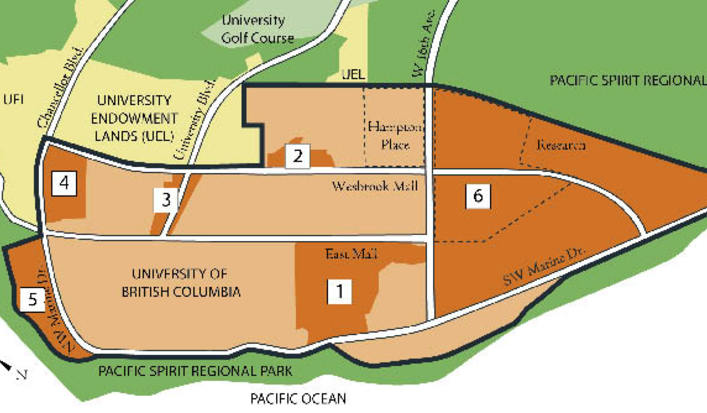
University Town
|
|
|
|
|
Certifications & Awards
Project Team
- Responsible Parties: External Affairs (University Town Office); University Town Committee; Campus and Community Planning; UBC Properties Trust
Green Building Audio
 Targeting LEED Green Education Credit?
Targeting LEED Green Education Credit?Our audio tours qualify.
Get one today!
Summary
Key Sustainability Features
Transformation from a commuter campus to a complete sustainable community
REAP (Residential Environment Assessment Program)
- Green building program based on LEED standards
- Required energy- and water-efficient design, water-efficient landscaping
- Rainwater collection and water recycling encouraged
- Required use of recycled construction materials
Pedestrian and Cyclist-oriented street design
- Residences within 250 m of greenways and 400 m of transit
- Fine-grained, narrow, traffic calmed street network
Traffic Demand Management (TDM)
- TDM is an important cornerstone of the University Town vision
- Stats show an overall reduction in parking due to success of U-pass (universal transit program) in 2003
- U-pass program to be extended to residents, faculty/staff
The University of British Columbia (UBC) was originally designed in 1914 as a traditional commuter campus. The vision behind University Town is of a community that integrates the academic core with a new, vibrant, and sustainable residential community. While many universities grow out of communities, UBC's University Town is growing out of the university. The end goal is an integrated, sustainable university community which provides a new model in community building that will help reduce UBC's greenhouse gas emissions.
The idea of a University Town is not new. The urban vitality found at Ann Arbor, Columbia, Harvard, and Berkeley, in addition to other great historic/urban universities (Sorbonne, Oxford, Cambridge and Bologna) is a testament to the historical – and inherently sustainable – success of this 'town and gown' concept.
All of the land sold for market residential housing in University Town is on the basis of pre-paid 99-year leases. Net revenues from the sales of 99-year leases are invested in endowments to serve the University's academic mission (i.e. scholarships, bursaries and research chairs).
University Town is creating six new neighbourhoods that will add a sustainable community of housing, shops, parks, and other amenities into the academic and cultural fabric of campus life. New housing for the university community is an important recruitment tool to attract and retain faculty, students, and staff. It also helps to reduce the number of vehicles coming to the campus. Fifty percent of all new housing is targeted at people who work or study at UBC.
Tours: Open to the public.
This post was imported from the 'Greater Vancouver Green Guide', it's part of the 'Green Guide Portal' to the Green Building Brain.
